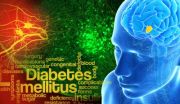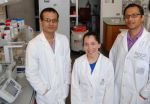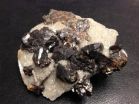(Press-News.org) An evolutionarily ancient and tiny part of the brain tracks expectations about nasty events, finds new UCL research.
The study, published in Proceedings of the National Academy of Sciences, demonstrates for the first time that the human habenula, half the size of a pea, tracks predictions about negative events, like painful electric shocks, suggesting a role in learning from bad experiences.
Brain scans from 23 healthy volunteers showed that the habenula activates in response to pictures associated with painful electric shocks, with the opposite occurring for pictures that predicted winning money.
Previous studies in animals have found that habenula activity leads to avoidance as it suppresses dopamine, a brain chemical that drives motivation. In animals, habenula cells have been found to fire when bad things happen or are anticipated.
"The habenula tracks our experiences, responding more the worse something is expected to be," says senior author Dr Jonathan Roiser of the UCL Institute of Cognitive Neuroscience. "For example, the habenula responds much more strongly when an electric shock is almost certain than when it is unlikely. In this study we showed that the habenula doesn't just express whether something leads to negative events or not; it signals quite how much bad outcomes are expected."
During the experiment, healthy volunteers were placed inside a functional magnetic resonance imaging (fMRI) scanner, and brain images were collected at high resolution because the habenula is so small. Volunteers were shown a random sequence of pictures each followed by a set chance of a good or bad outcome, occasionally pressing a button simply to show they were paying attention. Habenula activation tracked the changing expectation of bad and good events.
"Fascinatingly, people were slower to press the button when the picture was associated with getting shocked, even though their response had no bearing on the outcome." says lead author Dr Rebecca Lawson, also at the UCL Institute of Cognitive Neuroscience. "Furthermore, the slower people responded, the more reliably their habenula tracked associations with shocks. This demonstrates a crucial link between the habenula and motivated behaviour, which may be the result of dopamine suppression."
The habenula has previously been linked to depression, and this study shows how it could be involved in causing symptoms such low motivation, pessimism and a focus on negative experiences. A hyperactive habenula could cause people to make disproportionately negative predictions.
"Other work shows that ketamine, which has profound and immediate benefits in patients who failed to respond to standard antidepressant medication, specifically dampens down habenula activity," says Dr Roiser. "Therefore, understanding the habenula could help us to develop better treatments for treatment-resistant depression."
INFORMATION:
The research was funded by the Medical Research Council.
The bit of your brain that signals how bad things could be
An evolutionarily ancient and tiny part of the brain tracks expectations about nasty events
2014-07-28
ELSE PRESS RELEASES FROM THIS DATE:
Cell's recycling center implicated in division decisions
2014-07-28
Most cells do not divide unless there is enough oxygen present to support their offspring, but certain cancer cells and other cell types circumvent this rule. Researchers at The Johns Hopkins University have now identified a mechanism that overrides the cells' warning signals, enabling cancers to continue to divide even without a robust blood supply. In the process, the researchers found that lysosomes — the cell's protein "recycling centers" — help govern cell division decisions. They also uncovered new evidence that certain drugs can halt the growth of tumors that have ...
Facial features are the key to first impressions
2014-07-28
A new study by researchers in the Department of Psychology at the University of York shows that it is possible to accurately predict first impressions using measurements of physical features in everyday images of faces, such as those found on social media.
When we look at a picture of a face we rapidly form judgements about a person's character, for example whether they are friendly, trustworthy or competent. Even though it is not clear how accurate they are, these first impressions can influence our subsequent behaviour (for example, judgements of competence based on ...
Scripps Florida scientists find genetic mutations linked to salivary gland tumors
2014-07-28
JUPITER, FL - July 28, 2014 – Research conducted at the Florida campus of The Scripps Research Institute (TSRI) has discovered links between a set of genes known to promote tumor growth and mucoepidermoid carcinoma, an oral cancer that affects the salivary glands. The discovery could help physicians develop new treatments that target the cancer's underlying genetic causes.
The research, recently published online ahead of print by the Proceedings of the National Academy of Sciences, shows that a pair of proteins joined together by a genetic mutation—known as CRTC1/MAML2 ...
Glucose 'control switch' in the brain key to both types of diabetes
2014-07-28
Researchers at Yale School of Medicine have pinpointed a mechanism in part of the brain that is key to sensing glucose levels in the blood, linking it to both type 1 and type 2 diabetes. The findings are published in the July 28 issue of Proceedings of the National Academies of Sciences.
"We've discovered that the prolyl endopeptidase enzyme — located in a part of the hypothalamus known as the ventromedial nucleus — sets a series of steps in motion that control glucose levels in the blood," said lead author Sabrina Diano, professor in the Departments of Obstetrics, Gynecology ...
Physicists unlock nature of high-temperature superconductivity
2014-07-28
Physicists have identified the "quantum glue" that underlies a promising type of superconductivity -- a crucial step towards the creation of energy superhighways that conduct electricity without current loss.
The research, published online in the Proceedings of the National Academy of Sciences, is a collaboration between theoretical physicists led by Dirk Morr, professor of physics at the University of Illinois at Chicago, and experimentalists led by Seamus J.C. Davis of Cornell University and Brookhaven National Laboratory.
The earliest superconducting materials required ...
Google searches hold key to future market crashes
2014-07-28
A team of researchers from Warwick Business School and Boston University have developed a method to automatically identify topics that people search for on Google before subsequent stock market falls.
Applied to data between 2004 and 2012, the method shows that increases in searches for business and politics preceded falls in the stock market. The study, 'Quantifying the semantics of search behavior before stock market moves,' was published in the Proceedings of the National Academy of Sciences.
The researchers suggest that this method could be applied to help identify ...
Memory relies on astrocytes, the brain's lesser known cells
2014-07-28
VIDEO:
Salk scientists have discovered the link between astrocytes and memory.
Click here for more information.
LA JOLLA—When you're expecting something—like the meal you've ordered at a restaurant—or when something captures your interest, unique electrical rhythms sweep through your brain.
These waves are called gamma oscillations and they reflect a symphony of cells—both excitatory and inhibitory—playing together in an orchestrated way. Though their role has been debated, ...
Scientists discover genetic switch that can prevent peripheral vascular disease in mice
2014-07-28
Millions of people in the United States have a circulatory problem of the legs called peripheral vascular disease. It can be painful and may even require surgery in serious cases. This disease can lead to severe skeletal muscle wasting and, in turn, limb amputation.
At The University of Texas Health Science Center at Houston (UTHealth) Medical School, scientists tested a non-surgical preventative treatment in a mouse model of the disease and it was associated with increased blood circulation. Their proof-of-concept study appears in the journal Cell Reports.
Unlike ...
Mineral magic? Common mineral capable of making and breaking bonds
2014-07-28
TEMPE, Ariz. - Reactions among minerals and organic compounds in hydrothermal environments are critical components of the Earth's deep carbon cycle, they provide energy for the deep biosphere, and may have implications for the origins of life. However, very little is known about how minerals influence organic reactions. A team of researchers from Arizona State University have demonstrated how a common mineral acts as a catalysts for specific hydrothermal organic reactions – negating the need for toxic solvents or expensive reagents.
At the heart of organic chemistry, ...
Forced mutations doom HIV
2014-07-28
CAMBRIDGE, MA -- Fifteen years ago, MIT professor John Essigmann and colleagues from the University of Washington had a novel idea for an HIV drug. They thought if they could induce the virus to mutate uncontrollably, they could force it to weaken and eventually die out — a strategy that our immune system uses against many viruses.
The researchers developed such a drug, which caused HIV to mutate at an enhanced rate, as expected. But it did not eliminate the virus from patients in a small clinical trial reported in 2011. In a new study, however, Essigmann and colleagues ...
LAST 30 PRESS RELEASES:
Q&A: How TikTok’s ‘black box’ algorithm and design shape user behavior
American Academy of Arts and Sciences elects three NYU faculty as 2024 fellows
A closed-loop drug-delivery system could improve chemotherapy
MIT scientists tune the entanglement structure in an array of qubits
Geologists discover rocks with the oldest evidence yet of Earth’s magnetic field
It’s easier now to treat opioid addiction with medication -- but use has changed little
Researchers publish final results of key clinical trial for gene therapy for sickle cell disease
Identifying proteins causally related to COVID-19, healthspan and lifespan
New study reveals how AI can enhance flexibility, efficiency for customer service centers
UT School of Natural Resources team receives grant to remove ‘forever chemicals’ from water
Sweet potato quality analysis is enhanced with hyperspectral imaging and AI
Use of acid reflux drugs linked to higher risk of migraine
For immigrants to Canada, risk of MS increases with proportion of life spent there
Targeted use of enfortumab vedotin for the treatment of advanced urothelial carcinoma
A university lecture, with a dash of jumping jacks
How light can vaporize water without the need for heat
These giant, prehistoric salmon had tusk-like teeth
New study infers our wellbeing by analyzing the language we use around ageing, using language markers to enable "a different type of access to individuals’ inner worlds"
New research confirms plastic production is directly linked to plastic pollution
MSU researchers uncover 'parallel universe' in tomato genetics
Grey cuckoo, red cuckoo: unveiling the genomic secrets of color polymorphism in female cuckoo birds
CHOP researchers discover underlying biology behind Fontan-associated liver disease
A flexible microdisplay can monitor brain activity in real-time during brain surgery
Diversity and productivity go branch-in-branch
Color variants in cuckoos: the advantages of rareness
Laser technology offers breakthrough in detecting illegal ivory
Why can’t robots outrun animals?
After spinal cord injury, neurons wreak havoc on metabolism
Network model unifies recency and central tendency biases
Ludwig Lausanne scientists identify and show how to target a key tumor defense against immune attack
[Press-News.org] The bit of your brain that signals how bad things could beAn evolutionarily ancient and tiny part of the brain tracks expectations about nasty events





